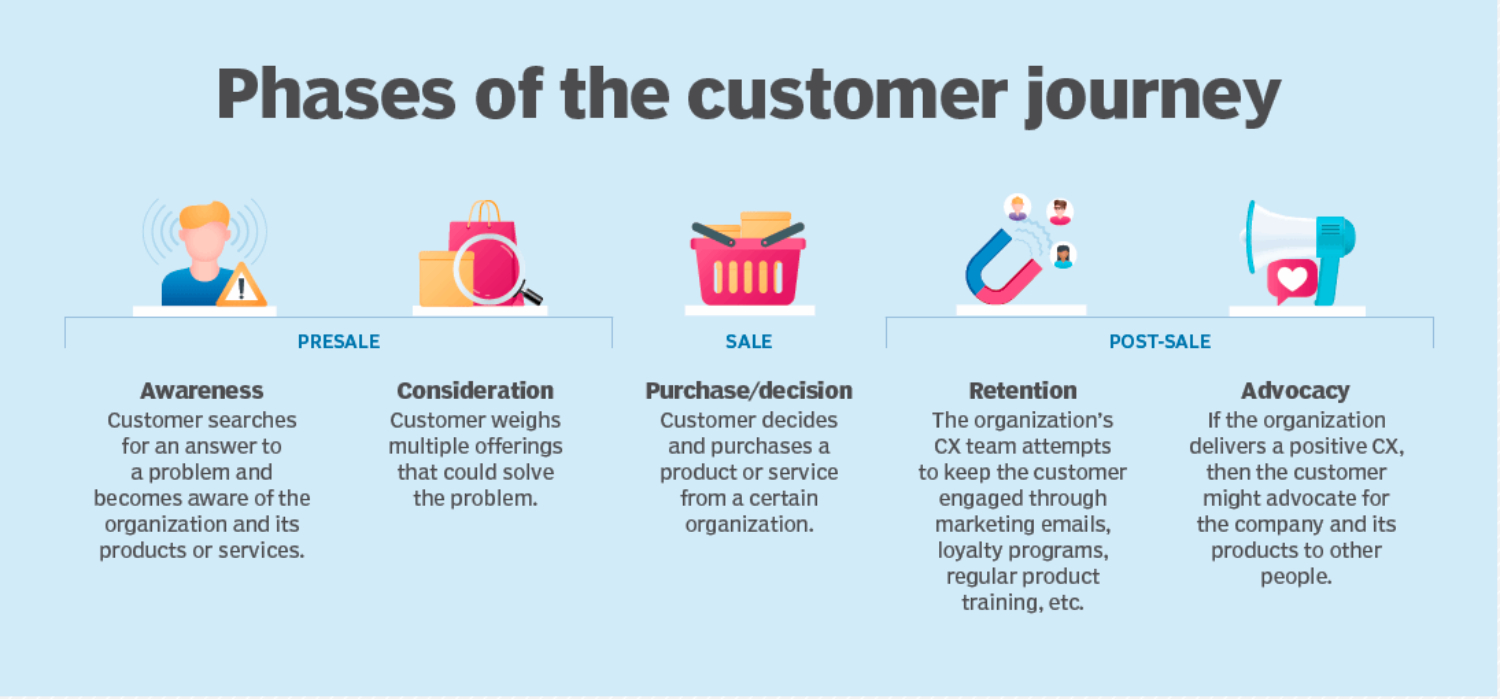Mapping how customers move from learning about a brand to becoming loyal fans reveals opportunities businesses can seize to improve experience and results at every step.
The customer value journey outlines customers’ key moments with a business, from discovery to advocacy, showing where issues arise and enhancements that can boost satisfaction.
The complete article covers the stages within a typical customer value journey, how optimizing each stage enhances metrics like retention and referrals, and why the journey demands ongoing refinement as customer needs change.
Customer Value Journey: Recognizing the Experience
Have you ever questioned why certain businesses consistently provide outstanding client service while others strive to do so? Part of the difference lies in understanding customers’ complete experience with a brand – from when they first hear about it to when they become diehard fans.
The “customer value journey” concept traces customers’ pivotal moments and interactions with a business. At every step, companies can either impress customers or fall short.
Visit: 7 Interesting Real-Life Customer Journey Map Examples
Key Points About The Customer Value Journey
The customer value journey gives businesses a big-picture view of the entire customer experience from start to finish. This reveals opportunities to:
- Make processes more streamlined and intuitive at every step. Reduce hassles and friction for customers.
- Improve interactions to be more personalized and empathy-driven. Focus on customers’ priorities, pain points, and desired outcomes.
- Collaborate across departments to develop solutions that span the full customer journey. Involve marketing, sales, product, service, and support teams.
- Focus relentlessly on the customer perspective. Recognize the objectives your clients strive to fulfill and how your services may best help them.
Mapping The Customer Value Journey
A typical customer’s journey with a brand may look something like this:
Discovery
Customers first learn about your business, perhaps through advertising, word-of-mouth, or web searches.
Consideration
Customers research your offerings and compare you to competitors, reading reviews and gathering information.
Purchase
Customers make their initial purchase online, in-store, or through another channel.
Onboarding
Post-purchase, customers are introduced to your product or service through onboarding resources like guides and tutorials.
Usage
Customers begin using what they bought and forming their first impressions.
Support
Customers may need help with issues or questions, testing how you resolve problems that arise.
Retention
Customers decide whether to continue being customers and make repeat purchases.
Advocacy
Satisfied customers become brand advocates, recommending you to others.
Visit: The 5A’s Customer Path: A framework that uses 5 stages to map a customer’s journey
How Exactly Does Studying The Customer Value Journey Help Me?
The customer value journey paradigm offers a straightforward yet effective lens for consumer comprehension. It aids in rethinking and redefining strategies for every facet of how a company engages with and caters to its clients.
What does that result in? A smooth, frictionless, and efficient customer experience.
And a frictionless customer experience pays off by:
- Winning over more new customers
- Retaining higher percentages of existing customers
- Increasing customer loyalty and lifetime value
- Generating positive word-of-mouth that fuels organic growth
See also: What is Lifecycle Marketing? Everything to Know
You Should Be Optimizing The Value Journey If You Haven’t Already
Businesses should experiment along the journey to identify what truly excites and delights customers rather than assuming they already know.
New technologies like AI, personalization, and the Internet of Things can help eliminate friction points and create a seamless experience.
Reasons Businesses Should Optimize The Customer Value Journey Steps:
Don’t Fall Behind – Your Competitors Are Already Doing It
If your competitors are mapping, analyzing, and improving the customer journey, they’re gaining an advantage in customer experience and satisfaction. You risk losing customers to more seamless, intuitive competitors.
Meeting Rising Customer Expectations
Today’s customers expect frictionless, personalized experiences at every interaction. Businesses need to optimize the customer value journey to keep up and meet these heightening expectations.
It Drives Real Growth
Studies show optimizing the customer journey boosts key metrics like new customer acquisition, customer retention, repeat purchase rates, and lifetime value – translating directly into revenue growth.
New Technologies Make it Easier.
Cloud computing, AI, big data, and other tools now enable businesses of all sizes to gain deeper insights into their customers’ journeys and pinpoint areas for improvement.
The Costs of NOT Doing It Are High.
Poor customer experiences, friction points, and failures along the customer value journey for a digital marketer, too, lead to dissatisfied, unhappy customers who stop buying from you. Acquiring new customers to replace “churn” is expensive.
Constantly Evolving Customer Behaviors
To stay relevant, businesses must continuously monitor how customers perceive and interact with brands at every stage of the value journey. Customer behaviors are changing rapidly.
It’s an Ongoing Process
Optimizing the customer value journey demands consistent monitoring, measuring, and refinement. The longer you wait, the more ground you have to make up to catch up to – and keep up with – competitors.
But remember that optimizing the customer value journey is an ongoing process. As customers’ needs evolve, businesses must evolve to remain relevant and provide what customers truly want and value.
Visit: 13 Benefits of Customer Journey Mapping
Improving The Value Journey
Businesses make targeted improvements by understanding where customers have friction points or positive experiences at each stage.
The better a company understands its customers’ value journey, the more likely it is to provide what customers truly need and want – cultivating loyalty, repeat business, and strong word-of-mouth.
Viewing every aspect of your business through the lens of the customer value journey reveals opportunities to enhance the experiences that keep customers coming back for more.
So examine your customers’ complete experience with your brand. Map their typical value journey from discovery to advocacy. Identify where you can optimize and improve every touchpoint.
Those efforts may be what transforms first-time buyers into lifelong fans and advocates. Understanding the customer value journey is key to genuinely delighting customers and building lasting relationships.
Frequently Asked Questions
How can companies map the journey?
Companies can identify the typical stages customers go through - from learning about the brand to becoming fans. They examine what happens and where customers interact at each step to find issues or ideas for improvements.
What are some common journey stages?
Typical stages include: when customers first hear about a brand, compare options, make purchases, onboard after buying, use products, need support, decide to remain loyal, and recommend the brand to others. But each business's journey will be a bit different.
How does optimization lead to growth?
By improving early experiences, businesses can acquire more customers. By resolving issues and exceeding expectations along the way, they can retain more current customers. And by satisfying existing customers, they can increase referrals from advocates - all adding up to higher lifetime value and growth over time.
Conclusion
Businesses that aspire to provide outstanding customer experiences, fuel growth, and stay ahead must prioritize their customers’ value journeys. The obvious benefits – and high costs of inaction- make acting swiftly imperative for any company striving to satisfy and delight customers genuinely.
Companies aiming for exceptional customer experiences, growth, and a competitive edge must pay attention to mapping and refining their customers’ value journeys. The clear advantages and the high risks of stagnation make acting promptly critical for any business seeking to satisfy and truly thrill customers.




